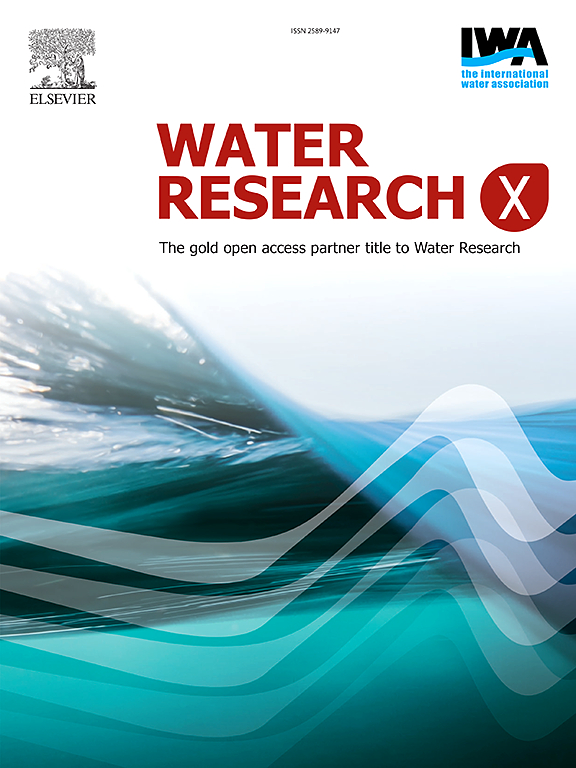Evaluation of nitrous oxide reduction in solid carbon source-driven counter-diffusional biofilm denitrification system
IF 7.2
2区 环境科学与生态学
Q1 ENGINEERING, ENVIRONMENTAL
引用次数: 0
Abstract
Solid carbon-driven biofilm system can provide sufficient carbon source for denitrification, while its counter-diffusional structure could inevitably induce the delayed carbon-nitrogen contact and electron transport, further affecting carbon footprints mainly contributed by nitrous oxide (N2O) at wastewater treatment plants (WWTPs). However, the detailed understanding of N2O dynamics during solid-phase denitrification (SPD) has not been disclosed. In this work, a fixed bed bioreactor driven by polycaprolactone (PCL) was constructed and operated over 180 days, achieving 97 %-99 % of total nitrogen (TN) removal efficiency. Biochemical results indicated that under the condition that each nitrogen oxide (NOx) concentration was maintained at 30 mg-N/L, the electron competition between upstream and downstream electron pools was still observed during PCL-driven denitrification even providing sufficient carbon source. For example, under the coexistent nitrate (NO3-)+ nitrite (NO2-)+N2O condition, few electrons (i.e., 12.6 %) distributed to N2O reductase (Nos), significantly decreasing the N2O reduction rate (i.e., 1.42 mg/g VSS/h). Under the condition that TN concentration was maintained at 30 mg-N/L, the TN removal rate in the scheme containing NO3-+NO2-+N2O was observed to be 1.75–2.3 times higher than that of the scheme with sole NOx of 30 mg-N/L. This suggested that when treating wastewater containing multiple NOx, the PCL-driven biofilm denitrification system can not only relatively improve the total nitrogen removal efficiency, but also relatively alleviate N2O emissions. The higher abundance of Bacteroidota and Comamonadaceae ensured the stable carbon source release and nitrogen conversion states.

固碳驱动的生物膜系统可为反硝化提供充足的碳源,而其反扩散结构不可避免地会引起碳氮接触和电子传递延迟,进一步影响主要由污水处理厂(WWTPs)中的一氧化二氮(N2O)造成的碳足迹。然而,关于固相脱硝过程中一氧化二氮动态的详细了解尚未披露。在这项工作中,构建了一个由聚己内酯(PCL)驱动的固定床生物反应器,并运行了 180 天,总氮(TN)去除率达到 97 %-99 %。生化结果表明,在氮氧化物(NOx)浓度保持在 30 mg-N/L 的条件下,即使提供充足的碳源,PCL 驱动的反硝化过程中仍会出现上下游电子池之间的电子竞争。例如,在硝酸盐(NO3-)+亚硝酸盐(NO2-)+N2O 共存的条件下,分配给 N2O 还原酶(Nos)的电子很少(即 12.6%),从而显著降低了 N2O 还原速率(即 1.42 mg/g VSS/h)。在 TN 浓度保持在 30 mg-N/L 的条件下,观察到含 NO3-+NO2-+N2O 方案的 TN 去除率是单 NOx 浓度为 30 mg-N/L 方案的 1.75-2.3 倍。这表明,在处理含有多种氮氧化物的废水时,PCL 驱动的生物膜反硝化系统不仅能相对提高总氮去除率,还能相对减少 N2O 的排放。类杆菌科(Bacteroidota)和拟杆菌科(Comamonadaceae)较高的丰度确保了稳定的碳源释放和氮转化状态。
本文章由计算机程序翻译,如有差异,请以英文原文为准。
求助全文
约1分钟内获得全文
求助全文
来源期刊

Water Research X
Environmental Science-Water Science and Technology
CiteScore
12.30
自引率
1.30%
发文量
19
期刊介绍:
Water Research X is a sister journal of Water Research, which follows a Gold Open Access model. It focuses on publishing concise, letter-style research papers, visionary perspectives and editorials, as well as mini-reviews on emerging topics. The Journal invites contributions from researchers worldwide on various aspects of the science and technology related to the human impact on the water cycle, water quality, and its global management.
 求助内容:
求助内容: 应助结果提醒方式:
应助结果提醒方式:


